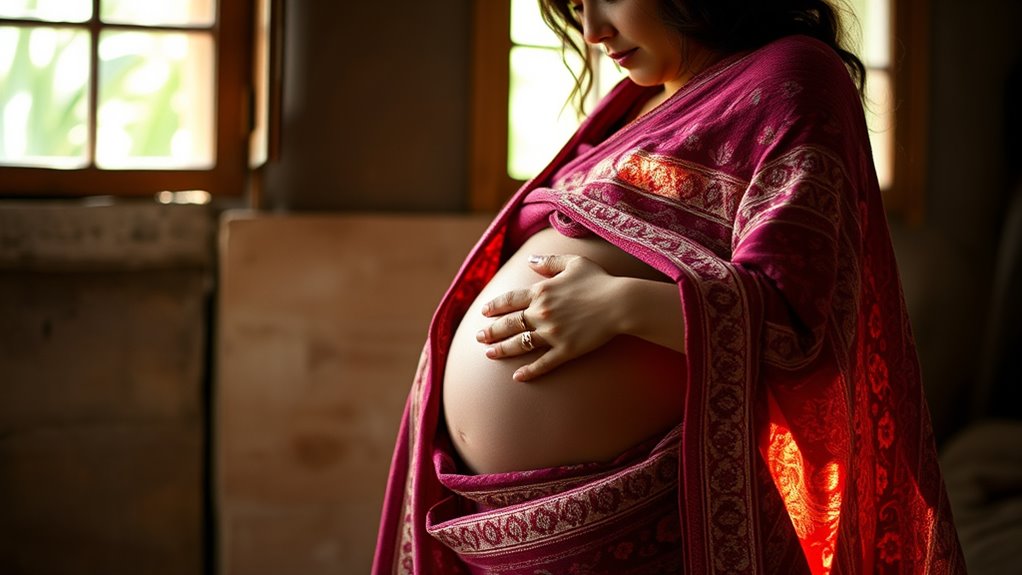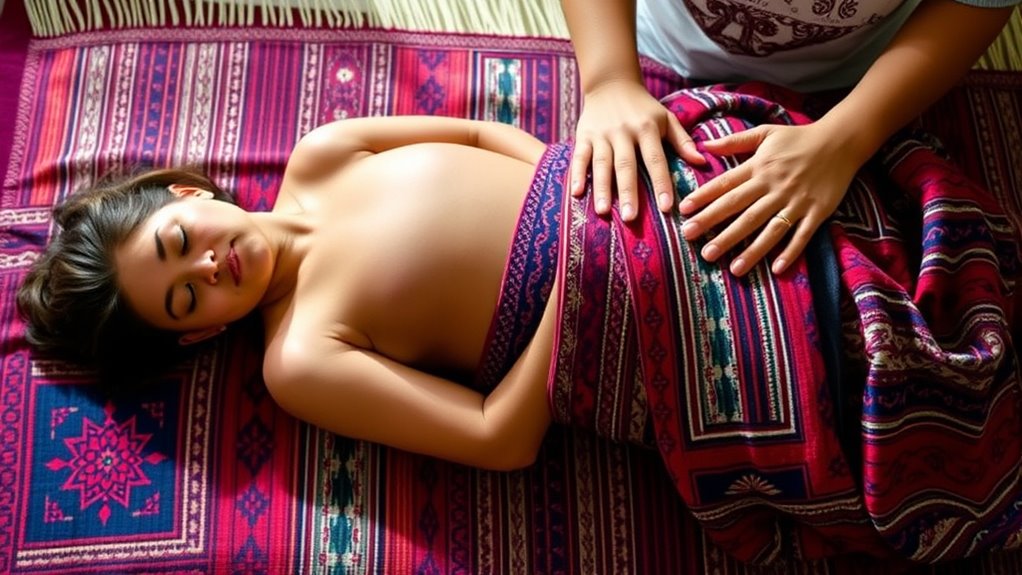The Mexican rebozo is a vibrant cultural symbol, woven with centuries of craftsmanship and tradition. It plays a essential role in prenatal care, helping expectant mothers relax, relieve tension, and support healthy fetal development. Using gentle techniques and symbolic patterns, rebozo massage fosters connection and preserves cultural heritage. If you want to discover how this beautiful tradition benefits both body and spirit, keep exploring its rich history and practices.
Key Takeaways
- The Mexican rebozo is a traditional textile symbolizing womanhood, cultural identity, and community bonds across generations.
- Rebozo prenatal massage uses culturally significant techniques and fabrics to promote relaxation, comfort, and fetal well-being during pregnancy.
- Crafted from natural fibers with symbolic patterns, rebozos reflect Mexican heritage, resilience, and artistic craftsmanship.
- Incorporating rebozo therapy helps preserve centuries-old cultural practices and connects communities to their ancestral roots.
- This practice embodies cultural pride, supporting physical health and spiritual well-being while honoring traditional Mexican rituals.
The Historical Roots of the Rebozo in Mexican Culture

The rebozo has deep roots in Mexican culture, serving as both a practical garment and a symbol of tradition. Historically, women used it for everyday activities like carrying children, providing warmth, or shielding themselves from the sun. It also played an essential role in ceremonies and rites of passage, symbolizing womanhood and social status. During pregnancy, women relied on the rebozo for support and comfort, passing down its use through generations. Its significance extends beyond utility, representing cultural identity and resilience. Over time, the rebozo evolved from a simple cloth to an emblem of heritage, often handmade with intricate designs. Embracing curiosity about its cultural significance can deepen your appreciation of Mexican traditions and their enduring importance. Understanding its historical roots helps you appreciate the deep connection between this garment and Mexican cultural values.
The Craftsmanship and Craft of Rebozo Weaving

When you observe a rebozo, you’ll notice the intricate weaving techniques that artisans have perfected over generations. These textiles are crafted from natural fibers and dyes, making each piece both beautiful and eco-friendly. The patterns often carry symbolic meanings, reflecting cultural stories and traditions woven into every thread. Additionally, the materials used in rebozo weaving often include sustainable options, emphasizing environmentally conscious craftsmanship.
Traditional Weaving Techniques
Traditional rebozo weaving is a meticulous craft rooted in centuries of Mexican artistry, where skilled artisans transform simple threads into intricate textiles. You’ll notice how they employ precise techniques like plain weave, twill, and double weaving to create both strength and flexibility. The weaving process involves careful tension control to produce uniform, durable fabric. Artisans often use traditional handlooms, ensuring every rebozo reflects cultural significance and craftsmanship. You might see complex patterns emerge from simple geometric shapes, achieved through detailed planning and skilled execution. The process demands patience and dedication, with each rebozo embodying the artisan’s expertise and cultural heritage. Additionally, textured fabrics add warmth and comfort to each piece, making the rebozo not only functional but also a tactile expression of tradition, resilience, and artistry passed down through generations.
Natural Fibers and Dyes
Natural fibers and dyes are central to the craftsmanship of rebozo weaving, embodying both cultural heritage and environmental consciousness. You’ll find that cotton, wool, and silk are preferred for their durability and natural feel. These fibers are carefully sourced, often from local farms, ensuring quality and sustainability. Dyes come from plant extracts, minerals, and insects, creating vibrant, lasting colors without synthetic chemicals. This method reflects a deep respect for nature and tradition. The table below highlights common fibers and dyes used:
| Fibers | Dyes |
|---|---|
| Cotton | Indigo, cochineal |
| Wool | Annatto, turmeric |
| Silk | Indigo, madder |
| Jute (less common) | Walnut hulls |
This craftsmanship preserves eco-friendly practices while honoring ancestral techniques and sustainable practices.
Symbolic Patterns and Meaning
The intricate patterns woven into a rebozo carry more than visual appeal—they embody a rich tapestry of cultural symbolism and personal meaning. Each design reflects regional traditions, stories, and social status, creating a unique connection between the weaver and wearer. For example, certain motifs symbolize protection, fertility, or community bonds, making the rebozo more than just a garment—it’s a cultural statement. As you feel the fabric’s patterns, you’re also embracing generations of craftsmanship and history. The careful selection of colors and symbols conveys messages that go beyond words, expressing hopes, identity, and spiritual beliefs. When you wear or gift a rebozo, you’re participating in a tradition that honors heritage, personal stories, and shared values woven into every thread. Additionally, the cultural significance of the patterns often guides the choice of design elements, making each rebozo a meaningful artifact.
The Significance of the Rebozo in Mexican Traditions and Rituals

You can see how the rebozo embodies Mexican cultural heritage and identity through its rich history. It plays an essential role in various rituals and healing practices, symbolizing more than just a garment. Exploring its significance reveals how deeply woven the rebozo is into traditions that honor and preserve Mexican roots. Additionally, the rebozo’s use in traditional healing practices highlights its importance beyond everyday attire.
Cultural Heritage and Identity
Because the rebozo embodies more than just a traditional garment, it holds deep cultural significance in Mexican heritage and identity. It’s a symbol of resilience, femininity, and community that connects generations. When you see a rebozo, you’re witnessing a piece of history woven into everyday life. Its role extends beyond fashion, serving as a marker of cultural pride and social bonds. You might notice:
- Its use in ceremonies, symbolizing protection and continuity.
- Its presence in celebrations, highlighting cultural roots.
- Its function in daily life, representing identity and tradition.
- Its significance in cultural heritage, reflecting the importance of traditional crafts and symbols.
Rituals and Healing Significance
In Mexican traditions, the rebozo plays an essential role in rituals and healing practices that connect body, mind, and community. You might see it used during childbirth, where it provides comfort and support, or in ceremonies to invoke protection and blessing. The rebozo’s versatility symbolizes cultural resilience and spiritual connection, often seen wrapped around women during important life moments. It’s believed to channel energy, ease pain, and promote relaxation, making it integral to prenatal care. Beyond physical support, the rebozo fosters a sense of unity and continuity within Mexican heritage. Its significance extends beyond practicality, serving as a symbol of cultural identity and spiritual well-being, reinforcing the deep-rooted belief in holistic healing traditions. This cultural significance underscores its role not only as a practical garment but also as a vessel of tradition and identity.
How Rebozo Prenatal Massage Supports Expectant Mothers

Rebozo prenatal massage offers expectant mothers targeted relief from common discomforts and promotes overall well-being during pregnancy. It helps reduce tension, alleviates back pain, and eases muscle stiffness, making daily activities more comfortable. The gentle, supportive techniques encourage relaxation and improve circulation, which supports healthy fetal development. Using the rebozo cloth, this massage also gently shifts the baby into ideal positions, potentially easing labor. You’ll feel a calming connection to your body, reducing stress and anxiety. Vetted products and techniques ensure safety and effectiveness during prenatal care.
Techniques and Practices for Rebozo Massage During Pregnancy

To effectively perform rebozo prenatal massage, practitioners employ specific techniques that promote comfort and relaxation for the mother. They begin by gently draping the rebozo scarf over her body, ensuring it’s snug but not tight. You’ll use slow, rhythmic movements such as rocking, gentle lifting, and wrapping to ease tension and improve circulation. Focus on key areas like the hips, lower back, and pelvis, applying gentle pressure to release tightness. Breathing exercises are often incorporated to enhance relaxation. Maintaining clear communication is essential—ask your client about her comfort level and adjust pressure accordingly. The goal is to create a calming environment that supports physical relief and emotional well-being throughout the massage. Incorporating proper positioning can further enhance comfort and effectiveness during the massage.
Preserving and Celebrating a Cultural Heritage Through Rebozo Therapy

Preserving and celebrating cultural heritage through rebozo therapy allows practitioners and communities to honor centuries-old traditions that connect them to their roots. By practicing and promoting rebozo techniques, you help keep a essential part of Mexican history alive. This practice isn’t just about physical comfort; it’s a way to pass down stories, rituals, and cultural knowledge across generations. You can:
- Share the history of the rebozo’s significance in maternity and community life
- Incorporate traditional rituals that honor cultural symbolism
- Educate others about the deep cultural roots embedded in this practice
Through these efforts, you ensure that the cultural legacy of the rebozo continues to thrive, enriching the lives of future generations.
Frequently Asked Questions
How Did the Rebozo Become a Symbol of Mexican Identity?
You might wonder how the rebozo became a symbol of Mexican identity. It originated as a traditional shawl used by indigenous women, reflecting Mexico’s rich cultural heritage. Over time, it gained significance in daily life, ceremonies, and even art. Its versatility and deep roots in history made it a powerful emblem of Mexican culture, representing resilience, femininity, and national pride.
Are There Specific Colors or Patterns Used in Traditional Rebozos?
Imagine a rebozo bursting with vibrant colors and intricate patterns that seem to dance with every movement. You’ll find traditional rebozos often feature bold reds, deep blues, and lush greens, adorned with delicate embroidery or geometric designs. These colors and patterns aren’t random; they reflect regional heritage, social status, and cultural stories, making each rebozo a wearable masterpiece that tells a unique Mexican tale.
Can Rebozo Massage Be Adapted for Different Pregnancy Stages?
You can definitely adapt rebozo massage for different pregnancy stages. During early pregnancy, gentle techniques help ease discomfort and promote relaxation. As you progress, more supportive methods can relieve tension and improve circulation. In later stages, modifications focus on comfort and safety, using lighter pressure and positioning. Always listen to your body and consult your healthcare provider to guarantee the massage suits your specific needs at each stage.
What Are the Safety Considerations for Prenatal Rebozo Massage?
You might think that a gentle massage sounds perfectly safe, but don’t forget safety is key. Always check with a healthcare provider first, especially if you have complications. Use gentle pressure, avoid deep or uncomfortable areas, and steer clear of certain positions. Keep the session brief, stay hydrated, and listen to your body. After all, the goal is relaxation, not a surprise trip to the emergency room.
How Is the Rebozo Used in Postnatal Recovery Practices?
You can use the rebozo in postnatal recovery to provide gentle support and comfort. It helps ease muscle tension, encourages relaxation, and can assist with abdominal and back pain. By wrapping or draping the rebozo around your body, you promote circulation and help realign your posture after childbirth. Incorporating it into your recovery routine offers soothing relief and promotes healing during this important time.
Conclusion
By embracing the rebozo and its traditional uses, you honor a rich cultural heritage that supports both physical and emotional well-being. Imagine a pregnant woman who finds comfort and relief through gentle rebozo massage, strengthening her bond with her cultural roots while preparing for motherhood. When you incorporate this beautiful practice, you’re not just nurturing yourself or others—you’re preserving a timeless tradition that connects generations. Embrace the rebozo and celebrate its enduring legacy.









